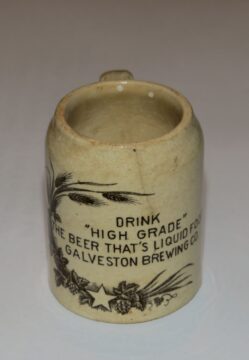By the early 1880s, the population of Texas had rapidly grown to more than two million residents, and many of them were immigrants. German immigrants in particular were attracted to opportunities available to them in the state, and many settled in Galveston or the nearby Houston area. With the influx of Germans came a demand for their drink of choice — beer.
Unfortunately, beer was often hard to come by. Prior to the 1870s and 1880s railroads were not as extensive in Texas and beer had to be shipped from one of the major St. Louis breweries down the Mississippi River, along the coast of Texas, and into the Port of Galveston. Therefore, transport with horse-drawn wagons on rough, unpaved roads provided less than ideal conditions for shipping beer.

The high demand for beer in Texas and the challenges with transporting it over such long distances led St. Louis brewers Adolphus Busch (of Anheuser-Busch fame) and William Lemp to expand their brewing interests into Galveston. In 1893, the two teamed up with several of Galveston’s wealthiest and most business-savvy citizens including Bertrand Adoue and John and William Reymershoffer. The men raised the $400,000 of capital needed to form a corporation, purchase equipment, and construct a state-of-the-art brewing facility on the island.
Galveston Brewing Company produced its first batch of beer in October 1896. A two-day public grand opening was held in February 1897. (The four-month delay was to allow for proper aging of the beer.) The impressive Romanesque-style brewery complex consisted of a large ice plant, a brew house, a storage house, a boiler house, a wash house, a racking house, and wagon sheds. The plant also had railroad tracks running along two sides. Beer was stored in adjacent cold rooms and loaded onto rail cars so that the product could be transported to the mainland for larger distribution. The Galveston Brewing Company was well-equipped to manufacture 100,000 barrels of beer annually.
Galveston Brewing Company’s original brew was similar to a light, Munich-style German beer that was popular in the warm Southern climate. Containing only 3.5% alcohol, the beer was advertised as a medicinal tonic “especially good for people of a nervous temperament and frequently prescribed by physicians.” Beers were sold under the “Seawall Bond” and “High Grade” product labels. The brewery was an immediate success and in less than ten years, the facility had to be expanded in order to meet production demands. Improvement included an ice plant with a 100-ton daily output and a bottling plant with a capacity of 30,000 bottles per day. Eventually more than 100 men were employed at the plant.

Just before Prohibition, the assets of the Galveston Brewing Company were sold to the Southern Beverage Company, established in 1917. The brewery managed to stay in business by producing a non-alcoholic “near beer” called Galvo as well as a successful line of flavored soft drinks. Their most popular beverage was Triple XXX Root Beer. Though it struggled financially for several years, Southern Beverage was one of the few breweries in the nation that managed to remain profitable during Prohibition.
With the repeal of Prohibition in 1934, the company was reorganized once again to become Galveston-Houston Breweries, Inc. after Southern Beverage merged with the Magnolia Brewery in Houston. Under new ownership, it produced the “Southern Select” beer brand. In 1955, Galveston-Houston Breweries was sold to the St. Louis-based Falstaff Brewery. Falstaff continued its operations in Galveston at the original site.

During the 1960s, Falstaff was the third largest brewer of American beer with several plants nation-wide. The company fell into financial decline through the 1970s which led to the closing of its Galveston facility in 1982. The last Falstaff brewery plant, located in Fort Wayne, Indiana, closed its doors in 1990. The Falstaff brand became licensed property of the Pabst Brewing Company who continued its production until 2005 when sales were in a deep decline.

In 2021 a new brewery in Galveston emerged known as Galveston Island Brewing. Their brand new facility has a wide range of specialty releases including a barrel aging program and a sour barrel aging program set to be released in 2023. In 2021, GIB brewed a little over 5,000 barrels for thirsty consumers. Galveston Island Brewing’s Tap Room is a top tourist destination in Galveston and is rated as one of the top things to do on TripAdvisor. Located on the west end of Galveston Island, and just a block from the beach, Galveston Island Brewing is a great stop on your tour of the island.
The Treasure of the Month is located on the library’s historic second floor near the East Entrance. It can be viewed during regular library hours, 9:00 a.m. to 5:45 p.m. Monday through Saturday. For museum questions, call 409.763.8854 Ext. 125 or email museum@rosenberg-library.org. For press inquiries, contact the Communications Coordinator.